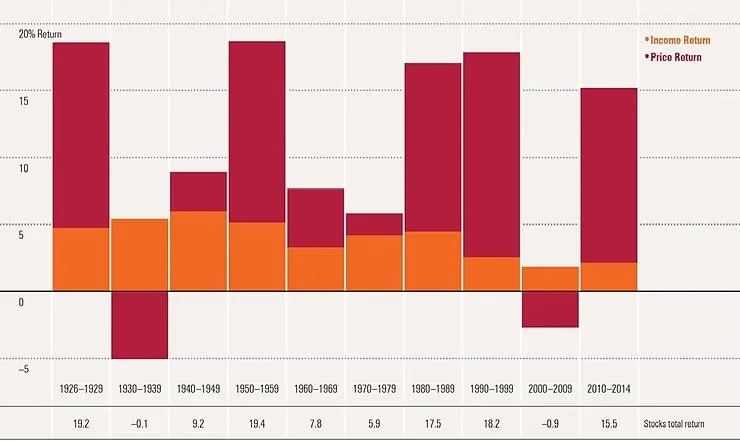Rising Dividends – A Strategy for Income or Growth
If you think dividends are boring, think again. According to Stocks for the Long Run, by Jeremy Siegel, about two thirds of the real (inflation-adjusted) returns from U.S. Stocks from 1871 to 1996 were attributable to dividends, and about one third of the (real) gains were attributable to capital appreciation. Please reread that last sentence. Dividends have historically provided more profit to investors than capital gains. Now don’t get me wrong, I want my stocks to go up. But, if you can get two thirds of the work done for you through income generation, then I think the concept is worth a second look.
Stock Market Total Return by from Income and Appreciation by Decade
Source: Morningstar
When investors purchase shares of a company, they are buying a claim on the earnings of that company. A dividend payment is merely the company returning part of those earnings to the shareholder in the form of a cash payment. Earnings that are not paid out as dividends can be reinvested back into the company for future growth. That future growth can generally come from stock buybacks or strategic acquisitions, the retirement of debt or to be reinvested for organic growth. In particular, I have a bias towards companies that have a good history of raising their dividends and that are expected to do so in the future. Please note that dividends are not guaranteed and can be cut or eliminated.
While the novice investor might view dividend paying stocks as stodgy, slow growing old companies, consider this. Companies that have historically had the ability to consistently raise their dividends over time tend to be high quality companies. By high quality, I am referring to companies with a high return on equity and low net debt relative to the median company in their sector or industry group. Return on equity is often used as a proxy for a company’s sustainable growth rate. Stocks of companies in fast growing industries like the biotechnology sector and the internet sector often have more exciting stories than your typical Dow component. However, consider the lodes of cash that these cash cows have historically returned to their shareholders each year with the prospect of growing that income stream over time. Rising dividend income can be extremely useful in fighting off the eroding effects of inflation on purchasing power. For those who don’t need the income to maintain their lifestyle there is always the option to reinvest the dividends into more shares. Income generation can be good for investors who need the income AND for investors who want to grow their investment capital.
For most of 2015, U.S. Stocks have been stuck in a choppy trading range. But dividend investors have been compensated with cash payments to wait for the uptrend to resume. If the uptrend doesn’t resume and stocks go down, dividends can provide a cushion and current income. While the yield on the stock market won’t erase the threat of a full blown bear market, it’s nice for the income investor to know that he is still being paid to ride through the storm. It’s also nice for the growth investor to know that he can use those dividends to pick up more shares at lower prices. Look at the how closely earnings, dividends, and price track each other over time in the chart of Johnson and Johnson below. Correlations like this exist because over time earnings drive stock prices and dividends are paid from earnings. So, do you still think dividends are boring?
The commentary on this website reflects the personal opinions, viewpoints and analyses of James Tharin and Emerald Asset Management, Inc. and should not be regarded as a description of advisory services provided by Emerald Asset Management, Inc. or performance returns of any Emerald Asset Management, Inc.’s Investments client. The views reflected in the commentary are subject to change at any time without notice. Nothing on this website constitutes investment advice, performance data or any recommendation that any particular security, portfolio of securities, transaction or investment strategy is suitable for any specific person. Any mention of a particular security and related performance data is not a recommendation to buy or sell that security. Emerald Asset Management, Inc. manages its clients’ accounts using a variety of investment techniques and strategies, which are not necessarily discussed in the commentary. Investments in securities involve the risk of loss. Past performance is no guarantee of future results.



